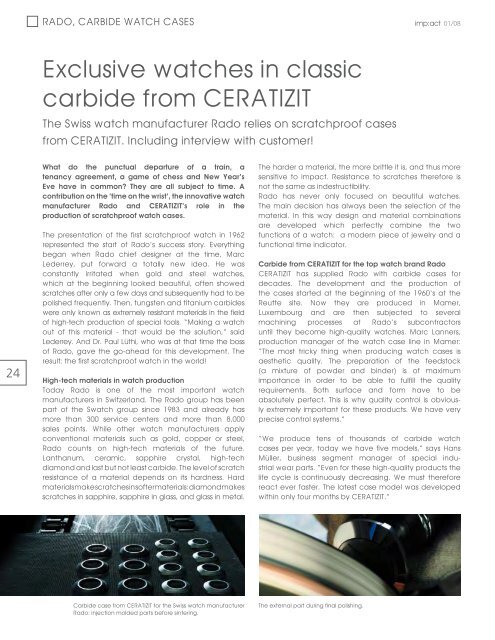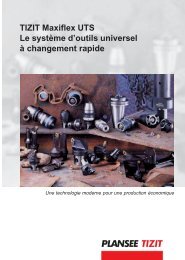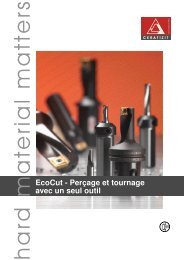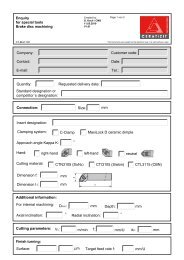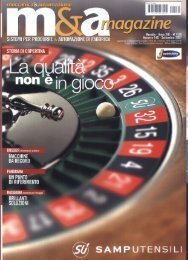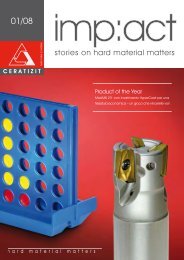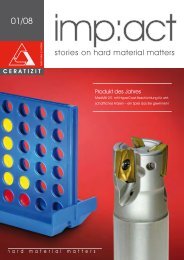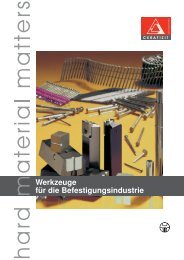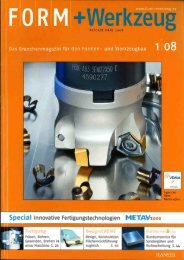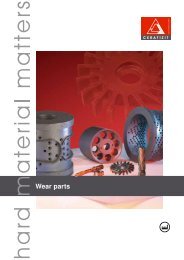stories on hard material matters - Ceratizit S.A.
stories on hard material matters - Ceratizit S.A.
stories on hard material matters - Ceratizit S.A.
You also want an ePaper? Increase the reach of your titles
YUMPU automatically turns print PDFs into web optimized ePapers that Google loves.
24<br />
RADO, CARBIDE WATCH CASES<br />
Exclusive watches in classic<br />
carbide from CERATIZIT<br />
The Swiss watch manufacturer Rado relies <strong>on</strong> scratchproof cases<br />
from CERATIZIT. Including interview with customer!<br />
What do the punctual departure of a train, a<br />
tenancy agreement, a game of chess and New Year’s<br />
Eve have in comm<strong>on</strong>? They are all subject to time. A<br />
c<strong>on</strong>tributi<strong>on</strong> <strong>on</strong> the ‘time <strong>on</strong> the wrist’, the innovative watch<br />
manufacturer Rado and CERATIZIT’s role in the<br />
producti<strong>on</strong> of scratchproof watch cases.<br />
The presentati<strong>on</strong> of the first scratchproof watch in 1962<br />
represented the start of Rado’s success story. Everything<br />
began when Rado chief designer at the time, Marc<br />
Lederrey, put forward a totally new idea. He was<br />
c<strong>on</strong>stantly irritated when gold and steel watches,<br />
which at the beginning looked beautiful, often showed<br />
scratches after <strong>on</strong>ly a few days and subsequently had to be<br />
polished frequently. Then, tungsten and titanium carbides<br />
were <strong>on</strong>ly known as extremely resistant <strong>material</strong>s in the field<br />
of high-tech producti<strong>on</strong> of special tools. “Making a watch<br />
out of this <strong>material</strong> - that would be the soluti<strong>on</strong>,“ said<br />
Lederrey. And Dr. Paul Lüthi, who was at that time the boss<br />
of Rado, gave the go-ahead for this development. The<br />
result: the first scratchproof watch in the world!<br />
High-tech <strong>material</strong>s in watch producti<strong>on</strong><br />
Today Rado is <strong>on</strong>e of the most important watch<br />
manufacturers in Switzerland. The Rado group has been<br />
part of the Swatch group since 1983 and already has<br />
more than 300 service centers and more than 8,000<br />
sales points. While other watch manufacturers apply<br />
c<strong>on</strong>venti<strong>on</strong>al <strong>material</strong>s such as gold, copper or steel,<br />
Rado counts <strong>on</strong> high-tech <strong>material</strong>s of the future.<br />
Lanthanum, ceramic, sapphire crystal, high-tech<br />
diam<strong>on</strong>d and last but not least carbide. The level of scratch<br />
resistance of a <strong>material</strong> depends <strong>on</strong> its <strong>hard</strong>ness. Hard<br />
<strong>material</strong>s make scratches in softer <strong>material</strong>s: diam<strong>on</strong>d makes<br />
scratches in sapphire, sapphire in glass, and glass in metal.<br />
Carbide case from CERATIZIT for the Swiss watch manufacturer<br />
Rado: injecti<strong>on</strong> molded parts before sintering.<br />
imp:act 01/08<br />
The <strong>hard</strong>er a <strong>material</strong>, the more brittle it is, and thus more<br />
sensitive to impact. Resistance to scratches therefore is<br />
not the same as indestructibility.<br />
Rado has never <strong>on</strong>ly focused <strong>on</strong> beautiful watches.<br />
The main decisi<strong>on</strong> has always been the selecti<strong>on</strong> of the<br />
<strong>material</strong>. In this way design and <strong>material</strong> combinati<strong>on</strong>s<br />
are developed which perfectly combine the two<br />
functi<strong>on</strong>s of a watch: a modern piece of jewelry and a<br />
functi<strong>on</strong>al time indicator.<br />
Carbide from CERATIZIT for the top watch brand Rado<br />
CERATIZIT has supplied Rado with carbide cases for<br />
decades. The development and the producti<strong>on</strong> of<br />
the cases started at the beginning of the 1960‘s at the<br />
Reutte site. Now they are produced in Mamer,<br />
Luxembourg and are then subjected to several<br />
machining processes at Rado’s subc<strong>on</strong>tractors<br />
until they become high-quality watches. Marc Lanners,<br />
producti<strong>on</strong> manager of the watch case line in Mamer:<br />
“The most tricky thing when producing watch cases is<br />
aesthetic quality. The preparati<strong>on</strong> of the feedstock<br />
(a mixture of powder and binder) is of maximum<br />
importance in order to be able to fulfill the quality<br />
requirements. Both surface and form have to be<br />
absolutely perfect. This is why quality c<strong>on</strong>trol is obviously<br />
extremely important for these products. We have very<br />
precise c<strong>on</strong>trol systems.”<br />
“We produce tens of thousands of carbide watch<br />
cases per year, today we have five models,” says Hans<br />
Müller, business segment manager of special indu-<br />
strial wear parts. “Even for these high-quality products the<br />
life cycle is c<strong>on</strong>tinuously decreasing. We must therefore<br />
react ever faster. The latest case model was developed<br />
within <strong>on</strong>ly four m<strong>on</strong>ths by CERATIZIT.”<br />
The external part during final polishing.


